|
The
Mk.1A was issued in the early 1950`s and was the first RAF
helmet with a fixed visor, the visor locked at various positions
and was issued in various tints from clear to dark tinted. The
RAF Mk.1A Flying Helmet superseded the Mk.1, this having a
separate visor fitted by elastic straps. The Mk.1A was
originally used by all front line pilots flying rotary &
fixed wing aircraft, this included subsonic & supersonic
aircraft, everything from early Hunters to Lightning's and
continued in limited use until the late 70`s and finally used by
training squadrons (EFTS/UAS) until the late 80`s. Although
designed to be used with the G-Type Helmet and H-Type
oxygen-mask, the helmet was also used with the A-13 oxygen-mask
& later the P-Type oxygen-mask. This later usage with the
P-Type mask caused wear & tear problems to the helmet edge
roll due to the protruding P-type mask fittings abrasing the
helmet leather lining & rubber edge trim. The Mk.1A was
originally issued in a silver colored shell, but later examples
were issued in matt Green or Grey. The helmet is leather lined
with a non-adjustable webbing harness.
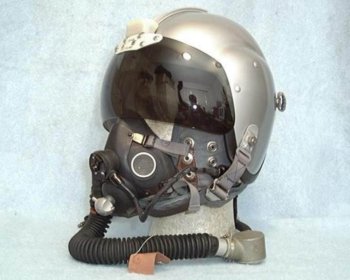
Mk.1A
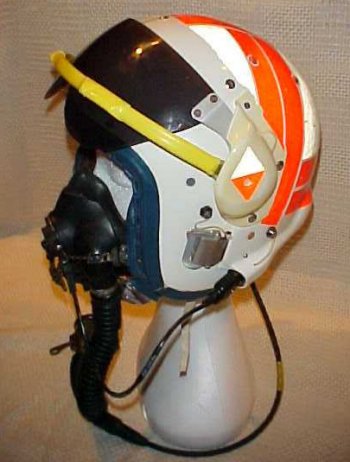
Mk.2
The
Mk.2 & 2A flying helmets take the place of the flying helmet
G Type and the protective helmet Mk.1A and provide the same
facilities as these separate in a single headpiece. In addition
they have retractable
anti-glare visors and blast screens which shut automatically in
the event of an ejection. The Mk.2 and Mk.2A helmets are
basically the same; the Mk.2A, however incorporates some minor
modifications. The
Mk.2A has a friction clutch adjustment on the visor mechanism
and has an operating handle bar of modified shape. Mk.2
and Mk.2A that where used in the Royal Navy had a cross of
adhesive reflective tape across the top of the shell for
improved recognition purposes. The helmet shell is made of
a glass fibre resinate with locally formed lobes to accommodate
the earphone receivers and microphone connector plug
respectively. The Mk.2 and Mk.2A helmets were originally
provided with a light plastic
shroud which protected the visor when in the raised position but
this was removed due to head space limitations within cockpits.
Unique to the Mk.2 & 2A flying helmets was the visor
operating mechanism. The visor screen is connected to
pivoting arms on each side of the helmets and is raised and
lowered by use of a handle bar. The handle bar is spring
loaded so when it is used to lower or raise the visor it never
comes within the view of the user.
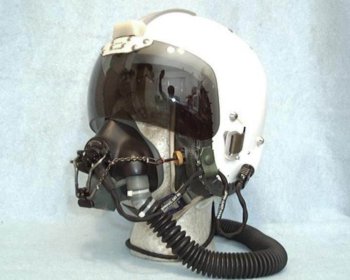
Mk.3B
The
Mk.3A/B flying helmets were Royal Air Force issue from the early
1970`s and superseded the G-Type/Mk.1A combination and Mk.2
& 2A flying helmets and were used by all front line pilots
flying rotary & fixed wing aircraft, this included subsonic
& supersonic aircraft, everything from early Hunters to
Lightning's. The Mk.3A was fitted with a boom mike for
helicopter and light aircraft applications and Mk.3B had
Oxygen-Mask hooks for use with the P/Q-Type oxygen-mask, both
have the same internal specifications as the Mk.3C flying
helmet. The Mk.3A/B helmet has a single visor which locks in
various positions on the center rail, these visors were issued
in various tints from clear to dark tinted and were eventually
superseded by the twin visor Mk.3C helmet
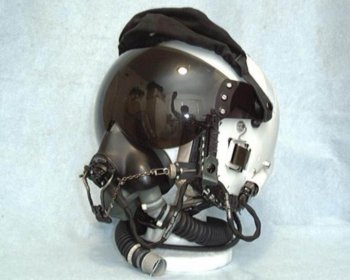
Mk.3C
The
Mk.3C supersedes the Mk.1A/G also the MK.2A & 3A/B type
helmets & will cover in one basic design a helmet for
aircrews concerned with low & high altitude (rotary &
fixed wing) with or without ejection seats. The rigid outer
shell of molded glass fibre resinate is provided with a lining
of shock absorbing cork. An internal cradle of nylon webbing
minimizes the transmitted force & distributes it over as
large an area of the head as possible. The soft comfortable
padded lining is replaceable & its attachment to the shell
forms a windproof seal, which together with the chinstrap, visor
& oxygen mask ensures security of the helmet under severe
blast conditions. The attachment of lining to shell is so
contrived that the lining can be removed either for replacement
or for access to the avionics equipment or other interior
fittings. A single miniature telephone No.13775 feeds the signal
via sound tubes to acoustically designed ear capsules, the
capsules on an adjustable light spring wire suspension can be
held away from the face when donning the helmet but seal snugly
on the head when tensioned by the chin & neck strap. The
telephone is fully tropicalised & wound to give impedance of
300 OHMS. & DC. resistance of 105 OHMS. The microphone plug
is conveniently situated low down on the cheek & accepts the
standard socket ref. 10H/14207. Headset seals & cable
assembly are all-replaceable either complete or as separate
items. The oxygen mask attachment hooks are designed for use
with a chain toggle harness MK.5 as on the P & Q type masks.
(The P & Q types are identical in design & differ in
size of facepiece, Q being smaller). These attachments are fully
adjustable; the knurled adjusters are immediately behind the
fitting hooks. The Mk.3C Helmet has a double visor system with a
side mounted polycarbonate inner visor for blast & bird
strike debris & an outer independently positioned anti-glare
visor, both superimposed on common pivots. A side mounted
locking device holds down the inner blast visor. The Mk.3A/B
helmet has a single visor that locks in various positions on the
centre rail, these visors were issued in various tints from
clear to dark tinted.
The Mk.4A Flying Helmet is current Royal Air Force / Royal Navy
/ Army Air corps issue and superseded the Mk.3C helmet in the
1980`s. The shell is made of glass fibre impregnated with
polyester resin and lined with shock absorbing expanded
polystyrene, the interior is fitted with a multi-point
adjustable webbing harness system with adjustable independently
suspended earcups. The helmet has a locking clear inner blast
visor and a friction mounted outer tinted visor with a
detachable cloth visor cover, avionics consist of twin 300ohm
speakers giving an impedance of 150 ohm (1khz) terminating with
a 18" downlead and single pin NATO jackplug, mounting
blocks allow the fitting of hooks for the P or Q type oxygen
mask. The Mk.4A has locating holes allowing the fitting of RAF
or similar Boom Mikes.
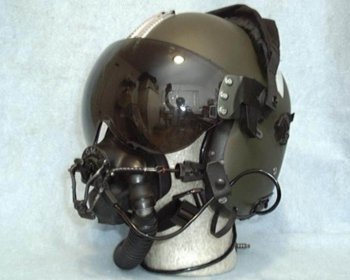
Mk.4A
The
Alpha MK.10 was first issued to the Royal Air Force in the late
1980`s and was not a general aircrew issue, these advanced
helmets were initially used by selected squadrons only and are
still now only in limited use. The helmet shell is made of
lightweight Kevlar® and glass fibre resinate lined with impact
attenuating foam with an adjustable leather lining, neck and
earcup fittings. These MK.10 variants are fitted with the
"INFINITE LOCKING" visor system that allows either
visor to be locked independently in any position. The avionics
consist of twin 300 ohm speakers giving an impedance of 150 ohm
(1khz) terminating with a 18" downlead and single pin NATO
jackplug, mounting blocks allow the fitting of hooks for the P
or Q type oxygen mask.
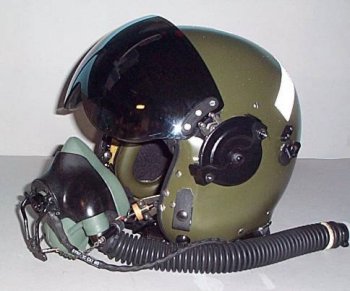
Mk.10
The
Alpha Mk.10B superseded the Mk.10 Helmet and although the Kevlar®
helmet shell was the same, the leather lining was substituted
with impact attenuating foam linings and a padded neck
protector. These helmets are fitted with the "LO-PRO"
visor system that allows either visor to be operated and locked
down independently, external "EARS" were fitted to
eliminate the levers becoming obstructed. Avionics consist of
twin 300ohm speakers giving an impedance of 150 ohm (1khz)
terminating with a 18" downlead and single pin NATO
jackplug, mounting blocks allow the fitting of hooks for the P
or Q type oxygen mask.
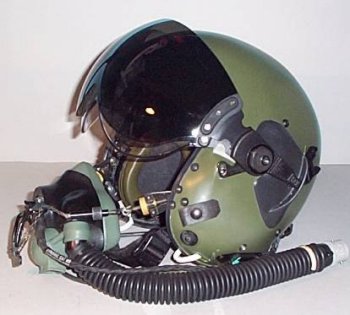
Mk.10B
The
ALPHA 700 is the top of the range RAF Flying helmet and like all
ALPHA helmets is constructed of glass fibre coated Kevlar, and
while being similar to a MK.10B helmet these "ULTRA
LIGHTWEIGHT 700" variants differ by shape and construction.
The external "EARS" are more contoured and are solid
as opposed to soft and unpainted as on the MK.10B. The interior
is modified allowing easier earcup access and removal these
being attached by Velcro to the suspension harness instead of
being attached by straps as on the 10B, internal padding is also
lighter and more sophisticated. The "LOW-PRO" visor
system allows either visor to be lowered and locked
independently. The avionics consist of twin 300-ohm speakers
giving impedance of 150 ohm (1khz) terminating with an 18"
downlead and single pin NATO jackplug. These Fighter Aircraft
variants are fitted with the latest issue Quick Release
oxygen-mask connectors and are complete with compatible P-Type
oxygen mask and fittings.
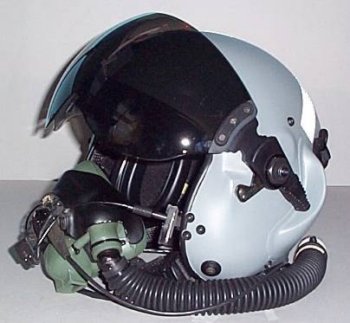
ALPHA 700
Note:
We would like to thank Mart
Aviation for this article. |